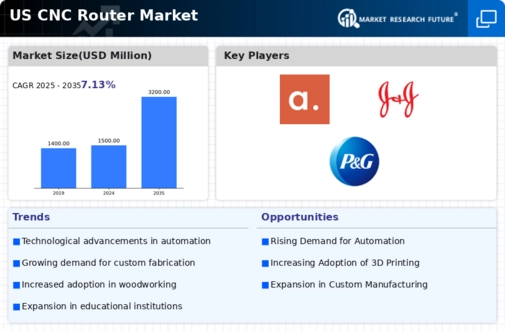Rising Demand for Automation
The increasing demand for automation in various industries is a key driver for the cnc router market. As manufacturers seek to enhance productivity and reduce labor costs, the adoption of automated solutions becomes essential. In the US, the manufacturing sector has seen a shift towards automated processes, with a reported growth of approximately 15% in automation technologies over the past few years. This trend is likely to continue, as companies recognize the efficiency and precision that cnc routers offer. The cnc router market is poised to benefit from this shift, as more businesses invest in advanced machinery to streamline operations and improve output quality. Furthermore, the integration of CNC technology with Industry 4.0 initiatives suggests a promising future for the market, as real-time data and connectivity enhance operational capabilities.
Advancements in Material Processing
Innovations in material processing technologies are emerging as a significant driver for the cnc router market. The ability to work with a diverse range of materials, including composites, plastics, and metals, is expanding the applications of cnc routers across various industries. In the US, the demand for advanced materials in sectors such as aerospace, automotive, and construction is on the rise, with a projected growth of 12% in the next five years. This trend suggests that the cnc router market will benefit from the increasing need for precision machining and cutting capabilities. As manufacturers seek to optimize their production processes, the versatility of cnc routers in handling different materials will likely enhance their appeal. Furthermore, the development of new cutting tools and techniques may further drive innovation within the market.
Focus on Education and Training Programs
The emphasis on education and training programs in the manufacturing sector is emerging as a crucial driver for the cnc router market. As the industry evolves, there is a growing need for skilled workers who can operate and maintain advanced machinery. Educational institutions and vocational training centers in the US are increasingly incorporating cnc technology into their curricula, preparing a new generation of skilled labor. This focus on training is likely to enhance the workforce's capabilities, thereby supporting the growth of the cnc router market. Furthermore, partnerships between educational institutions and manufacturing companies may facilitate knowledge transfer and innovation. As the demand for skilled operators increases, the cnc router market is expected to expand, driven by a well-trained workforce capable of leveraging advanced technologies.
Growth in Woodworking and Furniture Production
The resurgence of the woodworking and furniture production sectors in the US is significantly impacting the cnc router market. With a growing consumer preference for custom and handcrafted furniture, manufacturers are increasingly turning to cnc routers for precision cutting and shaping. The woodworking industry has experienced a growth rate of around 10% annually, driven by both residential and commercial demand. This trend indicates a robust market for cnc routers, as they provide the necessary versatility and accuracy for intricate designs. The cnc router market is likely to see further expansion as furniture makers adopt these technologies to meet consumer expectations for quality and customization. Additionally, the rise of e-commerce platforms has created new opportunities for furniture manufacturers, further fueling the demand for efficient production methods.
Increased Investment in Small and Medium Enterprises
The cnc router market is experiencing a boost due to increased investment in small and medium enterprises (SMEs) across the US. As these businesses seek to enhance their manufacturing capabilities, they are increasingly adopting cnc routers to improve efficiency and product quality. Reports indicate that SMEs account for approximately 50% of the manufacturing output in the US, highlighting their importance in the economy. The cnc router market is likely to benefit from this trend, as SMEs invest in advanced technologies to remain competitive. Additionally, government initiatives aimed at supporting small businesses may further stimulate growth in this sector. As SMEs continue to embrace automation and precision manufacturing, the demand for cnc routers is expected to rise, creating new opportunities for manufacturers and suppliers.














Leave a Comment